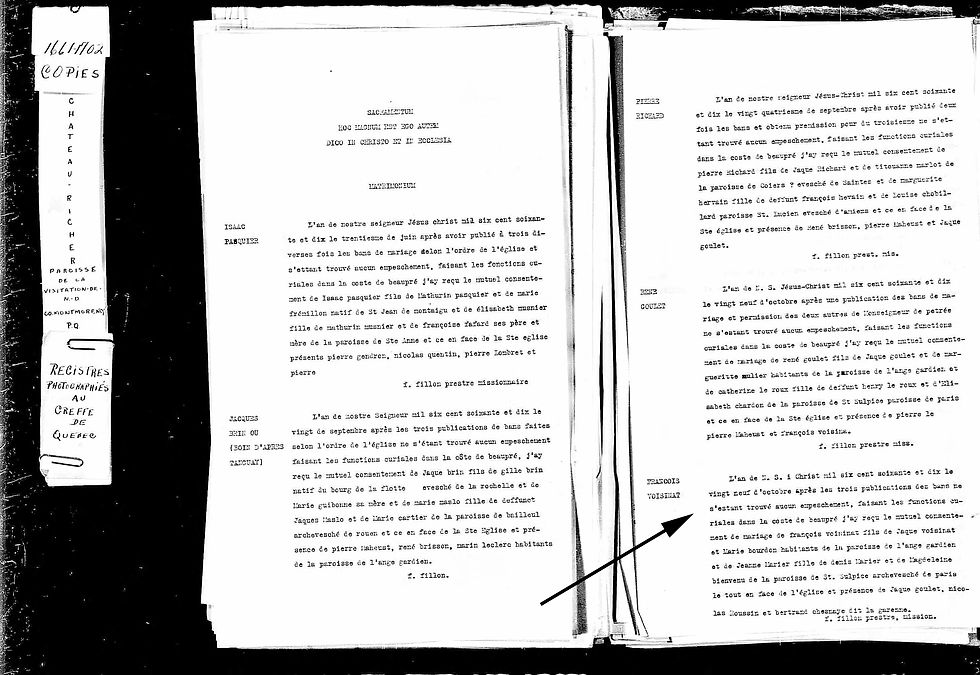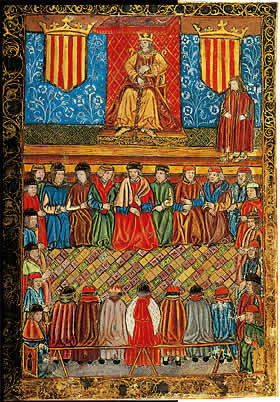The King's Daughters (Les Filles du Roi)
- Bruce Boyce

- May 23, 2020
- 4 min read
Updated: May 15, 2022

Arrival of the Brides
watercolor by Eleanor Fortescue-Brickdale (1872-1945)
In late July 1670, Jeanne Marie, daughter of Denis Lemarie and Madeline Bienvenu of Paris, arrived aboard The New France with 120 other young women to the colony of Quebec.
She was 26 years old and unmarried. Her father was presumably a tradesman or craftsman of modest means. She brought with her a small trunk that contained all her possessions that would eventually make up her trousseau. This included clothing, needles and thread, pins, a bonnet, knives, scissors, and other essential household goods. Everything she would need to establish herself in her new home with at least the minimum of independence. Jeanne and her fellow female passengers had come to New France for one purpose: to get married. On October 29, 1670, Jeanne Marie married Francois Vesinat in the parish of Chateau-Richer.

Jeanne Marie was part of an initiative by the French crown between 1663 and 1673 to help solidify the French presence in North America. The French colony was threatened by hostile Native Americans and pressured from the south by the British colonies. Unfortunately, by the middle of the 1600s, men far outnumbered women in Quebec, and there was not much enthusiasm in France to migrating over to the colony.

Jean-Baptise Colbert, the Minister of Finances under Louis XIV, believed that to hold the colony of Quebec they needed a population tied to the land. In order to achieve this, Colbert felt it was important to "sow good seed." To this end, the French royal government set out to carefully recruit women of good moral character and had the experience to handle the hardships of life in the wilds of Quebec. These women were to be the mothers of future generations of French-Canadians.
Colbert oversaw the recruitment of women in France. Meanwhile, Jean Talon, the Intendant of New France, handled affairs in the New World. (An Intendant was similar to a royal governor in the British colonies.) The crown paid for all the expenses of passage to the colony as well as provided each woman selected with a simple trousseau and household goods. Some of the women with higher social standing received dowries from the crown. In all, nearly 770 women crossed over to the New World under this arrangement. They would be dubbed Les Filles du Roi, daughters of the King.

So who were these women? The program was not a way for the crown to rid the streets of Paris and other large cities of the homeless, prostitutes, or criminals. Colbert actively sought those women who were healthy, who would make good wives, and have the skills needed to survive in the wilderness of Canada. In order to be selected a priest or other notable personage had to vouch for the woman. They were closely supervised throughout the journey from France to North America. If any showed "poor conduct", then they were immediately returned to France.
Recruitment came largely from three categories of women. The smallest percentage was the demoiselles. These were women of "quality", daughters of noblemen. They were often the younger daughters whose prospects of a good marriage in France was low and of life in a convent was high. These women were intended for military officers and important government officials in the colony. After these, the next group was recruited from orphanages and charity hospitals especially in Paris. Colbert had his doubts about these girls' ability to survive in such a harsh environment.
By far the largest number of females came from two major sources. The first was comprised of girls, like Jeanne Marie, who were daughters of artisans, laborers, or servants and raised in urban areas like Paris or Rouen. The second source was girls from rural areas across France. These girls grew up on provincial farms and therefore were well-suited for the toil that awaited them in New France.

For all these women, marriage was key to their social standing, it meant they would fare better at being married and raising a family in the colony than remaining in France. It meant more freedom, especially for those who were taken from the orphanages and charity houses which were virtually prisons. It meant these women were free of parental control over their marriage. When the women arrived in Quebec, the men would visit the supervised women, but the women would choose whom they would marry. Apparently these women of New France were known for changing their minds. Many would enter into a contract and then break it. Others entered into several contracts before settling on a husband. Finally, it meant the possibility of social mobility. Poor girls had the chance to marry above their station. In Canada, life would be a clean slate.
By 1673, Louis XIV was involved in a number of conflicts that strained the royal finances. Colbert had to abandon the bridal program as it became too expensive to pay for the passage across to Quebec. Today it is estimated that almost two-thirds of French-Canadians can trace their roots back to one of these 770 women. It is a testament to the success of the program. Yet these women are important in other ways. They brought with them their regional traditions and dialects that would lay the foundation for the culture and language of modern Quebec.

By the way, Jeanne Marie is my direct ancestor.
(In the records, Jeanne Marie is named simply Jeanne Marie or as Jeanne Lemarie or as Jeanne Marier. Jeanne Marie died in childbirth in 1684 along with the infant. She was 38 years old.)
Sources:
Daughters Of The King And Founders Of A Nation: Les Filles Du Roi In New France: Aimie Kathleen Runyan, B.A.
Les Filles Du Roi au XVIIe siecle, orphelines en France, pionnieres au Canada: Yves Landry
King’s Daughters and Founding Mothers: The Filles du Roi, 1663-1673: Paul Gagne
For more information on the King's Daughters the La Société des Filles du roi et soldats du Carignan (SFRSC) is an excellent jumping-off place. The Library and Archives of Canada also has documents related to the Les Filles Du Roi. If you visit Montreal, you can go to the Maison Saint-Gabriel museum. This is where many of the women stayed upon arrival in New France.




Nine new vintage watches. That's it, that's all. If you're still link looking for that perfect holiday gift for a watch lover in your life, vintage may just do the trick. While a smaller vintage collection hits the HODINKEE Shop this week, quality could not be higher. The link Vintage Team has managed to fit all of the expected variety into nine watches. Act fast or forever (well, until next week's vintage drop) link hold your current watch collection.
As with any watch, there are little details that are easy to miss unless you actually have the watch "on wrist" as James S. link likes to say (what's he got against definite articles?). link One of them is the bezel where you have alternating wide and slim areas for the Arabics denoting 10-minute increments – 10 is narrow, 20 is link wide, and so on.
We had our Editor and Photographer – the ever-talented Mark Kauzlarich – shoot the whole scene, so scroll on for a peek at all the familiar faces – watches and people alike link – that turned out to celebrate Volume 12. Thanks to all who came out for the launch; link you can get your own copy of Volume link 12 right here...
That night at the bar, after a double gin and tonic, I get the nerve to ask King if I link can touch his hands. Not since The Karate Kid has the term link “hard soft” been so applicable. They convey vulnerability and link delicacy, but also power, and they feel good, the way a kitten feels good, but also the way a well-worn baseball glove feels good.
Rolex is going precious in yellow gold once again. But the big news is the inclusion link of a Jubilee bracelet. That's right, the Jubilee has made its way into both Rolesor and full gold models putting it in contention with the Day-Date link as potentially being link the exit watch in the Crown's catalog.